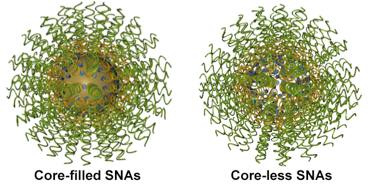Recent research demonstrates that CRISPR Spherical Nucleic Acids (SNAs) can be delivered across the cell membrane and into the nucleus, all while retaining bioactivity and capability of gene editing. Gene editing is technology which allows a scientist to change an organism’s DNA.
The work displayed in this article builds on a 25-year study to uncover the properties of SNAs and the factors that distinguish them from the blueprint of life. SNAs are structures typically composed of spherical nanoparticles covered with DNA or RNA, giving them chemical and physical properties different from those forms of nucleic acids found in nature.
A variety of SNAs exist, with cores and shells of different chemical compositions and sizes. SNAs are also now being evaluated as potent therapeutics in human clinical trials, such as trials for brain cancer and skin cancer.
According to nanotechnology pioneer Chad A. Mirkin, “these novel nanostructures provide a path for researchers to broaden the scope of CRISPR utility by dramatically expanding the types of cells and tissues that the CRISPR machinery can be delivered to.” “We already know SNAs provide privileged access to the skin, the brain, the eyes, the immune system, the GI track, heart and lungs. When this type of access is coupled to one of the most important innovations in biomedical science in the last quarter-century, good things will follow.”
Mirkin’s team used Cas9 (protein required for gene editing) as the core of the structure, and attached DNA strands to the surface to form a new type of SNA. These SNAs were also preloaded with RNA capable of performing gene editing and fused with peptides to control their ability to navigate compartmental barriers of the cell, making it the most efficient. In AP Biology, we learned that peptides are molecules containing two or more amino acids. Peptides that contain several amino acids are called polypeptides or proteins. These SNAs effectively enter cells without the use of transfection agents, and display high gene editing efficiency between 32% and 47% across several human and mouse cell lines.



Leave a Reply